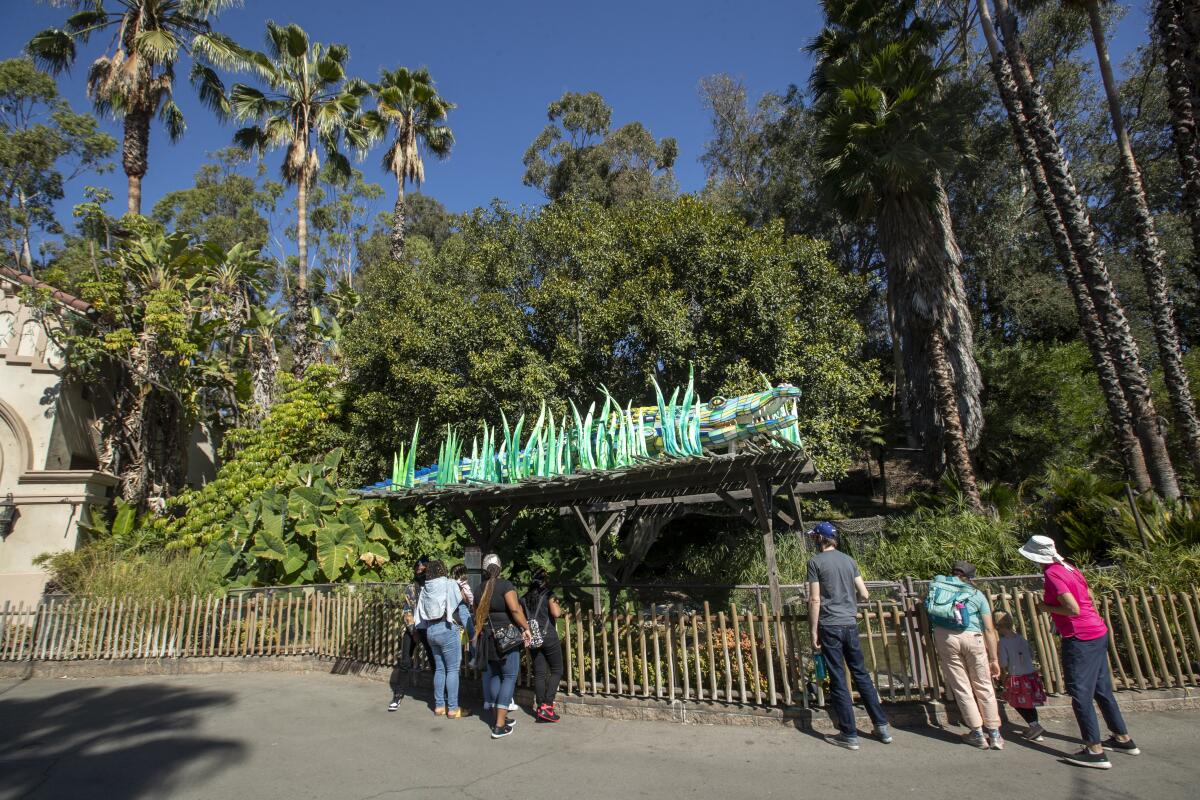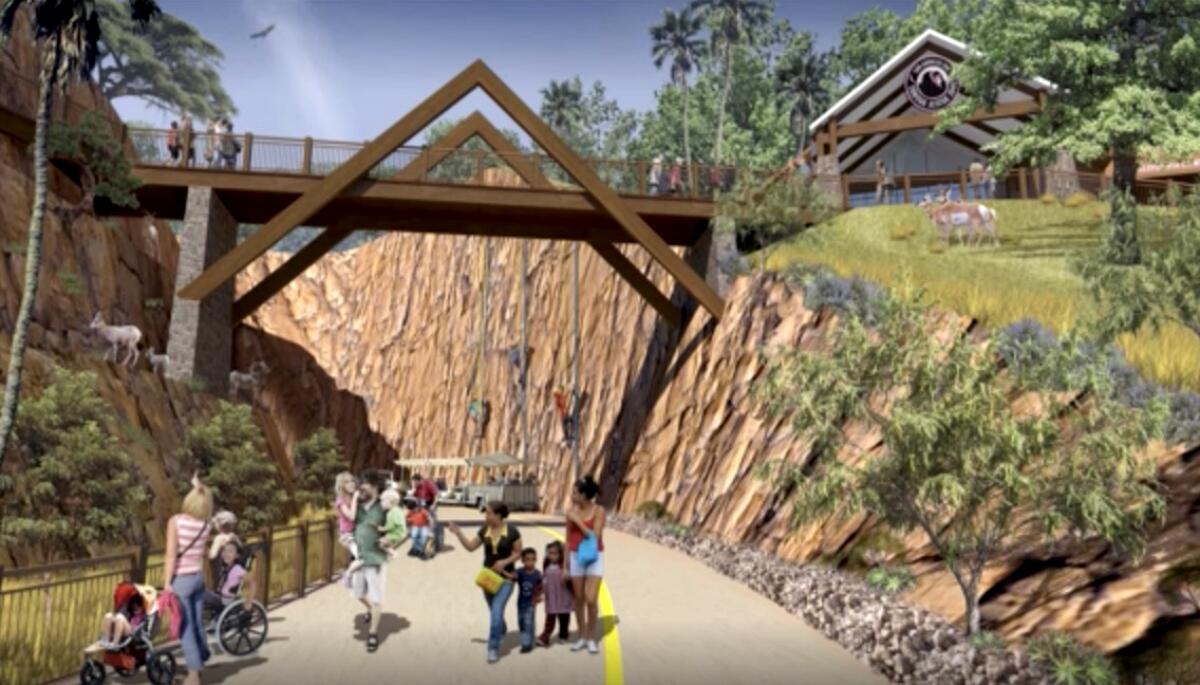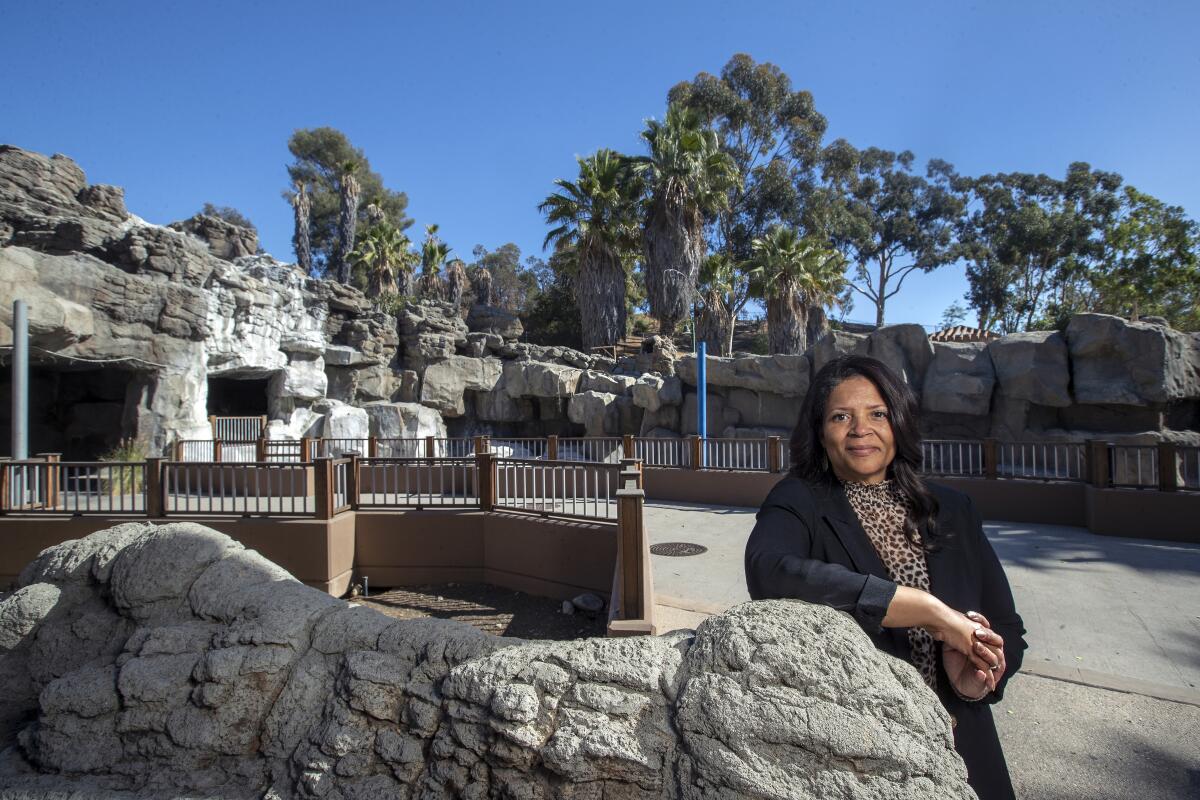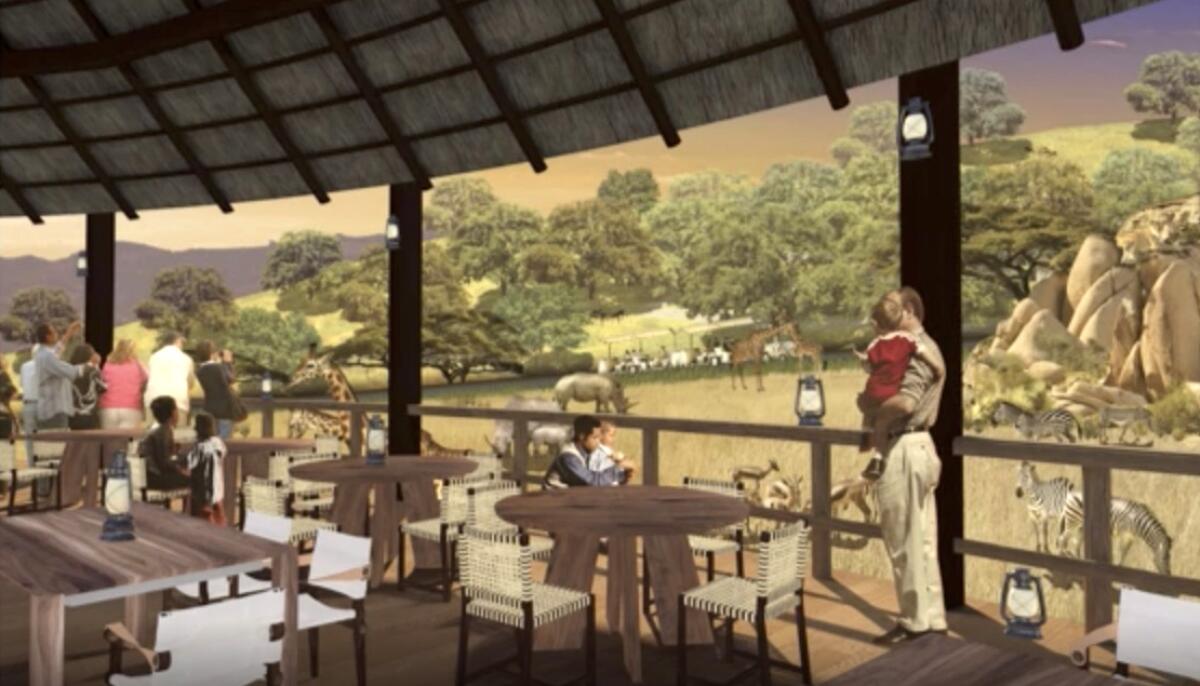A battle over the future of L.A. Zoo: Should it expand to compete with Disney, Universal?

- Share via
For 55 years, the Los Angeles Zoo has been a venerable but decidedly low-key attraction nestled amid the hills of Griffith Park.
But officials are considering a controversial transformation backers say would give it a competitive edge in a market dominated by powerhouse tourist attractions such as Disneyland, Magic Mountain, Universal Studios, SeaWorld and other destinations including the San Diego Zoo.
The $650-million plan involves removing nearly all its remaining native woodlands to make room for the makeover, and that is raising the ire of some environmentalists.
The zoo’s ambitious “20-year Vision Plan” calls for exhibit upgrades and flashy new tourist attractions, including a 60-foot-deep canyon offering rock climbs and a hilltop Yosemite lodge-style California Center with sweeping views of a 25,000-square-foot vineyard.

Backers say it would lure up to 3 million visitors annually by 2040 — an increase of about 72%, according to an environmental impact report for the plan.
But does the zoo need to consume 23 acres of native woodlands? That’s the question dividing defenders of 120 coast live oaks, 60 toyons, 22 California black walnut trees and stands of federally and state-listed endangered shrubs in the proposed development zones.
Opposition led by the historical preservation group Friends of Griffith Park and the California Native Plant Society has some advocates worried that the controversy will scare off funders and impede progress of the plan.

“We definitely had the Olympics in mind when we were developing this plan,” said Denise Verret, zoo director and chief executive. “What are we going to do to attract international travelers to the zoo as a place they should not miss?”
“We are not going to build in a vacuum with no regard for the undeveloped acreage in our zoo,” she said. “At this point, this plan is what we envision.”
It is a path toward “placing the L.A. Zoo at the top of the best-zoos-in-the-nation lists,” she added. “But that will take an investment.”
Now, just weeks before the plan is expected to be taken up by the Los Angeles City Council’s Arts, Parks, Health, Education, and Neighborhoods Committee, critics are ratcheting up efforts to promote a smaller-scale compromise. They say it would spare the woodlands that biologists say are home to the entire community of hawks and owls in Los Angeles, as well as other state species of special concern, including the Southern California legless lizard.
“The zoo’s plan refers to its native woodlands as ‘underutilized and underdeveloped areas,’” said Gerry Hans, president of the nonprofit Friends of Griffith Park. “We vehemently disagree with this assertion from the perspective of conservation and biodiversity.”
He also argues that the plan’s “amusement park-style approach” falls short by setting aside only 35% of the undeveloped natural space for conversion to animal care purposes.
The plan may not be worth the financial risk, he added, at a time when the zoo, which is owned and operated by the City of Los Angeles, relies on $11.6 million from the city’s general fund to meet its roughly $25-million fiscal budget for 2021-22.
Historians and zoo consultants, however, are not surprised by the zoo’s proposal.
Nigel Rothfels, a historian at the University of Wisconsin Milwaukee, said its fundamental goals are “absolutely in step with the history of zoos, which have always been for people, and not animals. They exist because people enjoy going to them.”
Behind the scenes, “large-scale municipal zoos in the United States and around the world have always been places of tension,” he said. “That’s because of the competing agendas embedded in them — education, scientific knowledge, conservation and recreation — and a constant desire to want to do things better.”
“Would the L.A. Zoo be better with climbing walls and a vineyard? ” he asked. “It remains to be seen whether tourists would say, ‘Wow. L.A. did a really great job with that!’”

Alan Sironen, owner and chief executive of Zoo Consultants International, suggested the plan is a good bet for the city. “Big-city zoos have to look at who they are competing against and the expectations of the international visitor,” he said. “Families coming to L.A. from all over the world during the 2028 Olympics are going to be looking for cool things to do.”
About 89% of the zoo’s annual visitors are residents of Los Angeles County, and the remaining 11% are tourists, zoo officials said.
Officials hope to raise funds for the master plan through grants and donations raised by the Greater Los Angeles Zoo Assn., the zoo’s private, nonprofit support group, and possibly a bond issue.
If approved by the Los Angeles City Council, construction would occur in seven phases starting next year. The splashiest improvements, along with development of more restaurants, classrooms and rental space for family and corporate events, could be completed within 10 years, officials said.
They include a 2,000-space parking structure; a redesigned main entrance; a 31,800-square-foot thatched-roof African Visitor Center overlooking a sprawling giraffe compound, and 60-foot-deep “Condor Canyon,” which would require blasting and excavation down to bedrock.
Also, on a fast track is the proposed California Visitor Center area in the heart of the zoo, which would add up to 22,400 square feet of food service facilities, expanded space for California wildlife exhibits — black bears, grizzly bears, bighorn sheep, pronghorns, wolves and mountain lions — and a funicular connected to an aerial tram.
The zoo, which has been accredited by the Assn. of Zoos and Aquariums for the last 27 years, is currently home to more than 1,100 mammals, birds, amphibians and reptiles representing 250 species. The plan would add luster to the zoo’s conservation achievements in helping bring critically endangered species such as the California condor and Southern California mountain yellow-legged frog back from the brink.
Critics, however, decry the scale of the proposal, and say it contradicts a new “conservation strategic plan” announced by the zoo in July.
Subscribers get early access to this story
We’re offering L.A. Times subscribers first access to our best journalism. Thank you for your support.
“The zoo’s plan is another attempt to squeeze more money out of Griffith Park, a designated L.A. Cultural-Historic Monument,” said Clare Darden, a board member of the Griffith J. Griffith Charitable Trust. “There is no need for another amusement park in L.A. But there is dire need for preserving its increasing rare native ecosystems.”
The compromise proposal supported by Friends of Griffith Park calls for reducing the zoo’s proposed footprint by eliminating development of Condor Canyon, the Africa and California project areas, the vineyards and funicular.
Zoo officials say the compromise would not generate as much revenue as its proposed expansion and may not be able to support the facility’s operations and overall financial success as a destination.
Los Angeles City Councilmember Nithya Raman, whose district includes Griffith Park, was unavailable for comment. But Stella Stahl, her spokesperson, said, “We agree that the zoo requires investment and updating. We have questions about the scale of the impact on Griffith Park and the natural habitat which we are working with the zoo to address.”
Over the decades, Griffith Park has become home to many popular attractions, including the Griffith Park Observatory, the Greek Theatre, the Autry Museum of the West, the Los Angeles Zoo, golf courses, pony and train rides, tennis courts, picnic grounds and concessions.
Yet, much of the 4,500-acre park remains wild, with mountain ranges up to 1,820 feet. Deer rove the high ground. Bobcats and a mountain lion known as P-22 prowl its chaparral-covered slopes and plunging canyons. Cooper’s hawks, peregrine falcons and California spotted owls roost in the boughs of trees in and around the zoo.
The California Department of Fish and Wildlife has warned that the zoo’s 20-year plan “should restore, at a minimum, equivalent acreage of impacted oak woodlands in approximately the same composition and orientation as project impacts.”
But Travis Longcore, science director at the Urban Wildlands Group, said that strategy would be insufficient. “Mitigation plantings,” he said, “never include the associated understory species of an intact oak woodland.”
Resolutions to such disagreements can’t come soon enough for Verret.
“Just completing phase 1 — a new main entrance and the California Visitor Center — would be a big development achievement,” she said. “It would whet the city’s appetite for more to come.”







